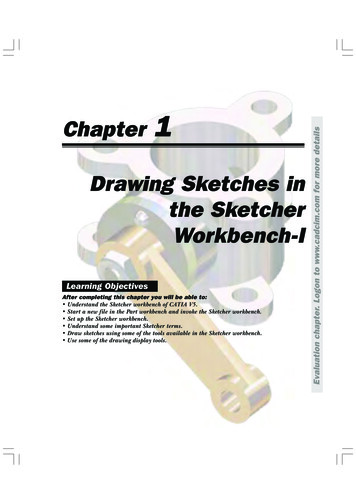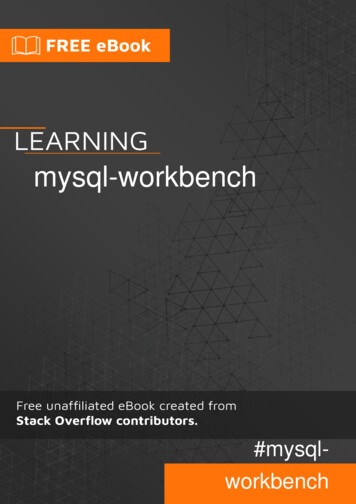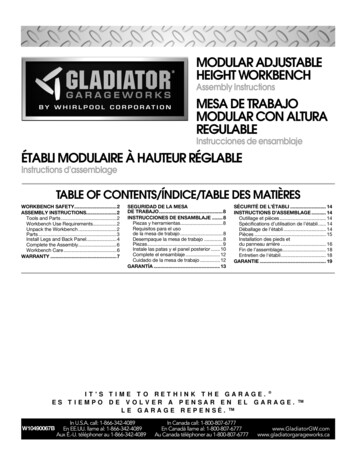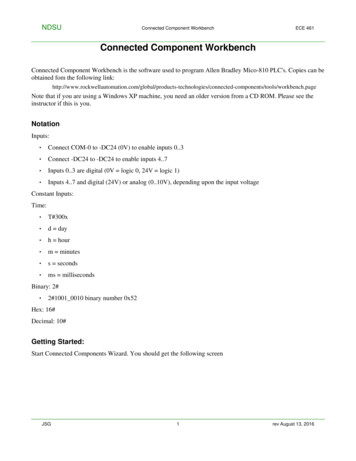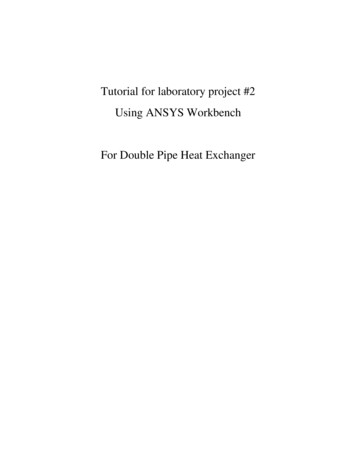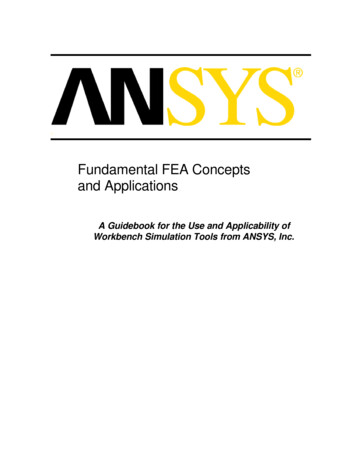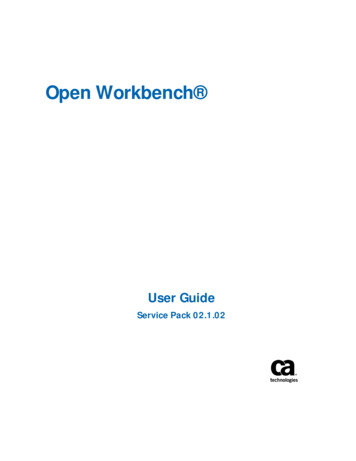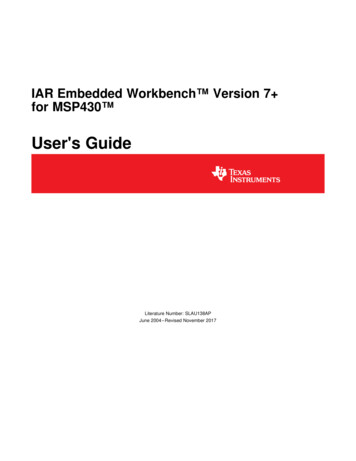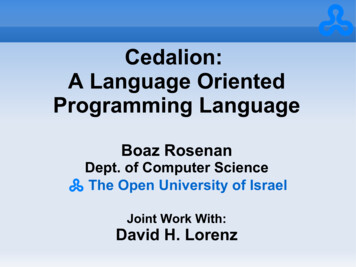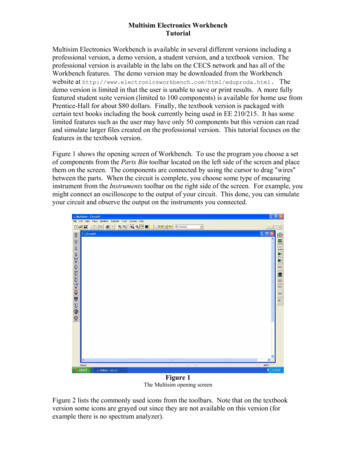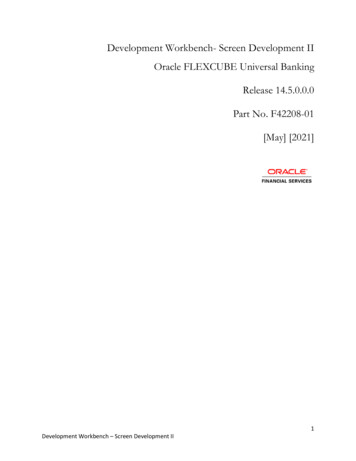
Transcription
Development Workbench- Screen Development IIOracle FLEXCUBE Universal BankingRelease 14.5.0.0.0Part No. F42208-01[May] [2021]Development Workbench – Screen Development II1
Contents1Preface . 31.1Audience . 31.2Related Documents . 32Introduction . 43Generated Files . 4453.1Front-End Files . 53.2System Packages . 63.3Hook Packages . 73.4Meta Data . 83.5Others . 10Deployment. 104.1Prerequisites: . 104.2Deploy Files: . 12Release . 135.1SVN Integration . 13Development Workbench – Screen Development II2
1 PrefaceThis document describes the generation, deployment and release of units from OracleFLEXCUBE Development Workbench for Universal Banking. This document explains theprocess of generating and deploying files from Development Workbench for a function id1.1 AudienceThis document is intended for FLEXCUBE Application developers/users that useDevelopment Workbench to develop various FLEXCUBE components.To Use this manual, you need conceptual and working knowledge of the below:1.2ProficiencyFLEXCUBE Functional ArchitectureResourcesTraining programs from OracleFinancial Software Services.FLEXCUBE Technical ArchitectureTraining programs from OracleFinancial Software Services.FLEXCUBE Object Naming conventionsDevelopment Overview GuideWorking knowledge of Web basedapplicationsSelf AcquiredWorking knowledge of Oracle DatabaseOracle DocumentationsWorking knowledge of PLSQL & SQLLanguageSelf AcquiredWorking knowledge of XML filesSelf AcquiredWorking Knowledge of DevelopmentWorkbench for Universal BankingUser ManualsRelated Documents04-Development WorkBench Screen Development-I.docx07-Development WorkBench Notifications.docxDevelopment Workbench – Screen Development II3
2 IntroductionThis document gives information on the following topics: Chapter 2 , “Introduction” Chapter 3 , “Generated Files"Chapter 4 , “Deployment”Chapter 5 , "Release”3 Generated FilesDevelopment Workbench generates following files as shown in the figure below. This screencan be launched by clicking onicon from the function generation screen . This has to bedone after design of screen is completed. Refer 04-Development WorkBenchScreen Development-I.docx for detailed explanation on screen developmentFig 3.1: File Generation ScreenFor action New , Workbench automatically selects the all files as shown in figure. If function IDhas been loaded .then hook packages will not be checkedClick on Generate button to generated the files selectedDevelopment Workbench – Screen Development II4
Fig 3.2: Files Generated message3.1Front-End FilesThese files need to be copied to application server in respective folders. RADXML This file contains the Data Used to Design screen. Radxml is Input toWorkbench.File Name : Function ID RAD.xml Screen Xml This file is an XML markup of presentation details, for the designedFunction ID specific to a language. XSL Transformation is applied to this XML file bylinking it to an XSL file. This results in HTML Markup which is displayed by thebrowser.File name : Function ID .xml System JS This JavaScript file mainly contains a list of declared variables used byFLEXCUBE Infra.omsgxml: - This variable is used by the system to build FCUBS Request XMLodataSrcLocationArray: - This variable is an array of DATA BLOCKSorelationArray:-This array contains relation and relation type details ofblocks.This is used for data bindingoretflds and bndFlds:- These arrays contains LOV informationDevelopment Workbench – Screen Development II5
oCallFormArray, CallFormRelat, CallRelatType:- These arrays contains callformdetails, call form relation and relation typeoactionsAmmendArray: - This array contains information for enabling fieldsbased on actionsFile name : Function ID SYS.js Release Specific JS Note: Release Specific JavaScript File will not be generated by Workbench. This file, ifrequired, has to be created by developer.This JavaScript file allows developer to add functional code and is specific to Release.The functions in this file are generally triggered by screen events. A developer workingin KERNEL release would add functions based on two categories: Functions triggered by screen loading eventsEg: fnPreLoad KERNEL(),fnPostLoad KERNEL() Functions triggered by screen action eventsEg: fnPreNew KERNEL (),fnPostNew KERNEL ()A developer working in CLUSTER release would add functions based on two categories: Functions triggered by screen loading eventsEg: fnPreLoad CLUSTER(),fnPostLoad CLUSTER() Functions triggered by screen action eventsEg: fnPreNew CLUSTER (),fnPostNew CLUSTER ()In case if any function in KERNEL JavaScript file has to be modified, this can beachieved by overriding the function in CLUSTER JavaScript file.The functions in this file are generally triggered by screen events. A developer workingin CUSTOM release would add functions based on two categories: Functions triggered by screen loading eventsEg: fnPreLoad CUSTOM(),fnPostLoad CUSTOM() Functions triggered by screen action eventsEg: fnPreNew CUSTOM (),fnPostNew CUSTOM ()In case if any function either in KERNEL JavaScript file or CLUSTER JavaScript file hasto be modified, this can be achieved by overriding the respective function in CUSTOMJavaScript fileFile name : Function ID RELEASE TYPE .js3.2System Packages Main Package Specification: The Main Package Spec Contains all the Declarations.Development Workbench – Screen Development II6
Main Package Body:Main Package would contain the all the business logic and persistence code for thefunctioned. It will also contain call to hook packages .Different flavors of main Packagegenerated are1) Maintenance FunctionId2) Transaction FunctionId3) Others Category FunctionId4) Report Parameter Screen5) Notification6) Purge EntityThe main package has the below stages in case of a maintenance function:oConverting Ts to PL/SQL Composite TypeoDefaulting and validating the dataoQuerying the Data from databaseoChecking for mandatory fieldsoWriting into DatabaseoConverting the Modified Composite Type again to TSEach of these stages has a ‘Pre’ and ‘Post’ hooks in the Release Specific Packages.Note : Main Package has the system-generated code and should not be modified by thedeveloper. Upload Package SpecificationUpload Package BodyUpload Packages would support adapter upload flow of any Function ID. The packagewill contain code to convert upload table data to function id specific PL/SQL compositetype. The main package of the functioned would be called to upload the data Notification TriggersThis will be generated only for notification trigger screens. Refer 07Development WorkBench Notifications.docx for further reference3.3 Hook PackagesKernel, Cluster and Custom Packages are the packages where the respective team canadd business logic in appropriate functions using the Pre and Post hooks available. Kernel Package SpecKernel Package BodyDevelopment Workbench – Screen Development II7
The Kernel package is solely for the Kernel Team to modify. The Main package hasdesignated calls to the Kernel package for executing any functional checks or validationsincluded in the Kernel Package.All the user level validations and conditional operations should be included inFn Post Default and Validate. This function is called from the Main Package after theexecution of Fn Default and Validate. User should avoid putting validations or code inany other function.In case user needs to add a separate function, the existing Workbench generatedstructure should not be changed. Instead the user can create a new package e.g. MODULE PKS FID UTILS package. The desired function can be included in thispackage and the call can be made from the Kernel Package. Cluster Package SpecCluster Package BodyThe Cluster package is available to the Cluster Team to add any validations or Checksspecific to the Cluster Team over and above the Kernel Team. The Kernel Team or theCustom Team should not modify the contents of this package. Custom Package SpecCustom Package BodyThe Custom package is available to the Custom Team only to add any validations orChecks over and above those already present in the Kernel and Cluster Packages.3.4Meta DataWorkbench generates INC files which contains insert scripts. These are static datarequired for the functioning of the function id. Developer needs to deploy generatedINC’s in FLEXCUBE schema. Menu Details Under menu Details below 4 table entry Insert Scripts will getgenerated.SMTB MENUSMTB FUNCTION DESCRIPTIONSMTB ROLE DETAILSMTB FCC FCJ MAPPINGIf any one of table entry missing while designing new function ID, FLEXCUBE won’tallow launching function ID. Data source Details Generates INC for CSTB FID DATA SOURCES. This data isrequired for uploading data to FLEXCUBE for the function id through excel.Development Workbench – Screen Development II8
Lov Details Generates INC for CSTB LOV INFO. FLEXCUBE will be using thisinformation to get data for List of values provided in the screenBlock Details Generates INC for CSTB FID DATA BLOCKS. This data is requiredfor uploading data to FLEXCUBE for the function id through excel.Screen Details Generates INC for CSTB FID SCREENS.Amendable details Generates INC for below table. These scripts providesinformation regarding the amendable fields in the screen .Entry has to be present for therequired field in these tables in order to make that field amendable through FLEXCUBEand gateway operation.GWTM AMEND MASTERGWTM AMEND NODESGWTM AMEND FIELDSGWTB AMEND NODESGWTB AMEND FIELDSCall form Details Generates INC for CSTB CALL FORM NODES. These will begenerated only if the screen is a Call Form. It is required for attaching the particular Callform to any other function id.Summary Details Generates INC for CSTB SUMMARY INFO. Dat in this table isrequired for fetching records in the summary screen of the particular function id .Label Details Generates INC for CSTB FIELD LABELS and CSTB OTHER LABELS.Labels can be used for Language translation of screens. These scripts providesinformation regarding the label codes attached to each field. These are useful whiledeveloping language packs for FLEXCUBECSTB FIELD LABELS Contains Field Label details.CSTB OTHER LABELS Contains SCREEN, TAB, FIELDSET, BLOCK etc labeldetails.Note that Workbench does not generate scripts for CSTB LABELS. Data inCSTB LABELS is maintenance required for the Tool.Block Pk Columns Generates INC for STTB AUDIT PK COLS.Function Call Forms Generates INC for CSTB FID CALLFORMS. This data isrequired for uploading data to FLEXCUBE for the function id through excel.Gateway Details Generates INC for below tables.Data in these tables are required for gateway operations (web services) for the particularscreenGWTM FCJ FUNCTIONSGWTM OPERATIONS MASTERNotification Details Generates INC for below tables. Notification INCs will getgenerated only for Notification screensGWTM NOTIFICATION TRIGGERSGWTM NOTIFICATIONS MASTERDevelopment Workbench – Screen Development II9
Function parameters Generates INC for below tables. This INC gets generates onlyfor Reports screens (i.e. Function Category – Report).AETB FUNC MASTERAETB FUNC DETAILPurge Details Generates INC for below tables . These scripts will be generated onlyfor Purge Entity Definitions screensSTTM PURGE MASTERSTTM PURGE TBL DETAILSSTTM PURGE FILTERS3.5 Others Xsds The XSD files are used for the creation of xmls, which are in turn used duringthe execution of operations through Gateway.Screen html The HTML files are used to take screen shots by converting them toimages, which in turn used for Document preparation.Upload Table Trigger Trigger will be generated for inserting records into adapterupload process tables (CSTB EXT CONTRACT STAT ,STTB UPLOAD MASTER)from upload tables.Upload Table definition DDL for upload tables would be generated. If existingupload tables are being re used , the generated DDL’s can ignoredArchive Table definition DDL for archival tables would be generated for PurgeEntity Radxml. Synonyms for the tables would also be generated.Note: For new screen all file options will be checked automatically. For modificationonly system generated files will be checked, based on user requirement can opt for otherfile generation.4DeploymentWorkbench generated files can be deployed directly to the application server and schema.Front-end files get copied to desired location which user has maintained while addingenvironment details. Database files get compiled to FLEXCUBE schema which is specifiedin the working environment.4.1Prerequisites:The below maintenance is required to use the deploy option.In environment user has two options to copy files based on the operating systemFLEXCUBE application is running. Windows : File Copy / FileManagerUnix: FileManagerDevelopment Workbench – Screen Development II10
FileManager Servlet needs to deploy in application server where FLEXCUBE is running.Refer File manager section in 02-Development WorkBench Administration.docx to getmore details about file manager.Fig 4.1: The Environment DetailsIn environment creation below details are mandatory to use deploy option. Application Operating System Unix/WindowsApplication Transfer Type Windows File Copy/FileManagerUNIX FileManagerJS Directory Path : Enter the shared path of JS files.Uixml Directory Path: Enter Shared path of Language Xml files.Note: If appliaction server is windows user can enter absolute path.Development Workbench – Screen Development II11
4.2 Deploy Files:Click Deploy button as shown in below image.Fig4.2: The deployment ScreenSelect required files to deploy .Click deploy button. On success full deployment userwill get status as Deployed.Development Workbench – Screen Development II12
Fig 4.3: Deployment of selected files5 ReleaseRelease feature of Workbench is applicable only for developers within Oracle Financials. Itinvolves the integration the Tool with other in house tools (repository/version control tools)Oracle FLEXCUBE Development Workbench is integrated with SVN.5.1 SVN IntegrationNow, Workbench provides an interface to release the units generated to SVNThe following prerequisite should be adhered to before attempting to release units to SVN1) SVN Repository URL should be provided in the Preferences Node of Function Id againstfield SVN Repository URL. Path till the module name has to be given.Example:- For an FT module RADXML path can be given asZ:\FCUBS 11.3.0\Soft\MAIN\FTDevelopment Workbench – Screen Development II13
Fig 5.2.1: Preferences Screen highlighting SVN Repository URLThe following files can be released to SVN through Development Workbench:1) RADXML2) Main Package(spc and sql)From the release screen check on the units to be released to SVN and click OK.SVN credentials has to be provided in the screen. SFR number has to beprovided if it is not a simple check in. If checked in successfully, status will bedisplayed as released.Development Workbench – Screen Development II14
Development Workbench – Screen Development II[May] [2021]Version 14.5.0.0.0Oracle Financial Services Software LimitedOracle ParkOff Western Express HighwayGoregaon (East)Mumbai, Maharashtra 400 063IndiaWorldwide Inquiries:Phone: 91 22 6718 3000Fax: 91 22 6718 3001www.oracle.com/financialservices/Copyright 2007, 2021, Oracle and/or its affiliates. All rights reserved.Oracle and Java are registered trademarks of Oracle and/or its affiliates. Other names may be trademarks of theirrespective owners.U.S. GOVERNMENT END USERS: Oracle programs, including any operating system, integrated software, any programsinstalled on the hardware, and/or documentation, delivered to U.S. Government end users are "commercial computersoftware" pursuant to the applicable Federal Acquisition Regulation and agency-specific supplemental regulations. Assuch, use, duplication, disclosure, modification, and adaptation of the programs, including any operating system,integrated software, any programs installed on the hardware, and/or documentation, shall be subject to license terms andlicense restrictions applicable to the programs. No other rights are granted to the U.S. Government.This software or hardware is developed for general use in a variety of information management applications. It is notdeveloped or intended for use in any inherently dangerous applications, including applications that may create a risk ofpersonal injury. If you use this software or hardware in dangerous applications, then you shall be responsible to take allappropriate failsafe, backup, redundancy, and other measures to ensure its safe use. Oracle Corporation and its affiliatesdisclaim any liability for any damages caused by use of this software or hardware in dangerous applications.This software and related documentation are provided under a license agreement containing restrictions on use anddisclosure and are protected by intellectual property laws. Except as expressly permitted in your license agreement orallowed by law, you may not use, copy, reproduce, translate, broadcast, modify, license, transmit, distribute, exhibit,perform, publish or display any part, in any form, or by any means. Reverse engineering, disassembly, or decompilation ofthis software, unless required by law for interoperability, is prohibited.The information contained herein is subject to change without notice and is not warranted to be error-free. If you find anyerrors, please report them to us in writing.This software or hardware and documentation may provide access to or information on content, products and servicesfrom third parties. Oracle Corporation and its affiliates are not responsible for and expressly disclaim all warranties of anykind with respect to third-party content, products, and services. Oracle Corporation and its affiliates will not beresponsible for any loss, costs, or damages incurred due to your access to or use of third-party content, products, orservices.Development Workbench – Screen Development II15
upload process tables (CSTB_EXT_CONTRACT_STAT ,STTB_UPLOAD_MASTER) from upload tables. Upload Table definition DDL for upload tables would be generated. If existing upload tables are being re used , the generated DDL's can ignored Archive Table definition DDL for archival tables would be generated for Purge Entity Radxml.
